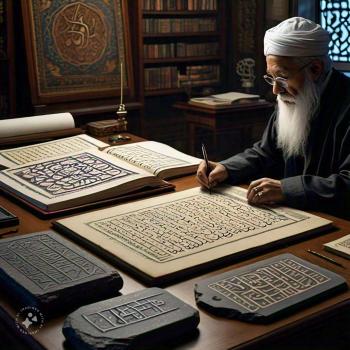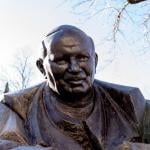
In the recent Patheos Answers article, Why Does It Seem Israel Is Always at War With Its Neighbors? we tackled the theological, geopolitical, and cultural dynamics fueling conflict in the Middle East today. Here, we take a look at the long history behind those modern tensions. From ancient tribal battles recorded in religious sacred texts to modern-day wars, the region known as the Holy Land has endured thousands of years of struggle.
This brief overview traces key moments in that long arc of conflict—conflicts that continue to shape both regional identity and international debate.
-
Cain and Abel (or Qabil and Habil): The very first recorded “conflict” in the region was between two of Adam and Eve’s children, Cain and Abel (or Qabil and Habil, as they are referred to in the Qur’an). It was a “mini-war” between two brothers that led to one being murdered by the other. According to the sacred texts of Judaism, Christianity, and Islam, the conflict was rooted primarily in religious issues, as God accepted the sacrificial offering of one brother and rejected the non-sacrificial “fruit” offering of the other. A secondary cause often seen by commentators in this “family war” is jealousy—Cain felt his younger brother was looked upon with favor by God. Some extra-canonical accounts also suggest that greed may have played a role in this conflict.
-
Tribal Conflicts: In the Patriarchal Period (beginning, according to scholars, around 1800 BCE), the descendants of Abraham, Isaac, and Jacob (whose name was changed by God to “Israel”) frequently lived in tension with other local tribes, including the people of Canaan and Philistia.
-
Joshua: During the time in which Moses’ successor, Joshua (circa 1200 BCE), led the “children of Israel,” the Bible says the Israelites entered the land of Canaan and conquered it. Through a series of battles (e.g., Jericho, Ai, Southern and Northern Canaan), the natives of that region are described as being wiped out by their conquerors. (Some historians question the historicity of these battles, but the biblical text claims that the ancient Israelites conquered various peoples at God’s command.)
-
Kings David and Solomon: After acquiring the lands and wealth of various peoples, Israel became a united people led by King David and then his son, King Solomon. During that time, there were wars between the people of Israel and other regional powers, including the Philistines. (However, after Solomon’s passing [circa 931 BCE], the kingdom split into Israel in the north and Judah in the south.)
-
Assyria: In the 8th century BCE, Israel (the Northern Kingdom) lost a battle with Assyria, and the “Ten Tribes” residing in that portion of the kingdom were exiled (722 BCE). This is often referred to as the “scattering of Israel.”
-
Babylon: In the 6th century BCE, Judah (the Southern Kingdom) lost a conflict with the Babylonians, resulting in their kingdom being conquered and their temple (known as “Solomon’s Temple” or Israel’s “First Temple”) being destroyed. Many of Israel’s most prominent people were exiled to Babylon (586 BCE).
-
Alexander the Great: While the Persian king Cyrus allowed Jews to return to Israel (538 BCE) to rebuild their temple, in the 4th century the region was again conquered, this time by Alexander the Great (332 BCE). This led to significant conflict, both religiously and culturally.
-
The Maccabean Revolt: Due to significant religious persecution under Grecian rule, the Jews revolted, which led to intense fighting and the establishment of the Hasmonean Kingdom. The Hasmoneans were initially only semi-autonomous but expanded their territory through conflict, gaining independence over time. However, that independence was short-lived, as Roman rule would soon reduce their Jerusalem-based kingdom’s power.
-
The Roman Republic: The Roman general Pompey conquered Jerusalem and the Hasmoneans (in 63 BCE), bringing the region under Roman rule. As Rome’s governmental structure evolved, the Israelites were ruled by local kings (often called “client kings”), such as Herod the Great. Once Herod died (4 BCE), his kingdom was divided among his sons. In 6 CE, Coponius—the first Roman prefect—was appointed to govern Judea (including Jerusalem), which had been annexed as a Roman province.
-
The Great Jewish Revolt: A major uprising took place in Judea (66–73 CE), during which the Jewish people fought the Roman authorities under whom they lived. This famously led to the destruction of Herod’s Temple (70 CE) and ultimately to a significant loss of life and a Jewish diaspora from the region.
-
The Bar Kokhba Revolt: This war (commonly called the “Third Jewish-Roman War”) was a Jewish uprising against the Romans (132–136 CE), led by a Jewish man, Simon bar Kokhba, whom some at the time perceived to be the Jewish Messiah. In the end, it brought mass killings, suppression of the practice of Judaism in the region, and another diaspora.
-
Muslim Conquest: By the 7th century CE, the Byzantine Empire held power in Jerusalem. However, in 638 CE, Muslim armies invaded and captured the city from the Byzantines, though they allowed Jews and Christians to continue living there. (While most of the previous conflicts directly involved the descendants of Jacob, or “Israel,” this conflict was primarily between Orthodox Christians and Arab Muslims.)
-
The Christian Crusades: From the 11th through 13th centuries, the city of Jerusalem was in constant upheaval. In 1099 CE, crusader armies captured the city and massacred not only the Muslim rulers but also the Jews who dwelt in the area. Then, in the 12th century, Saladin—the Muslim Sultan of Egypt and Syria—recaptured the city (1187 CE). Control of the city changed hands multiple times between 1099 and 1291, each time through warfare.
-
The Ottoman Empire: While Jerusalem and the region saw significant upheaval and warfare between the Christian Crusades (1099–1291 CE) and the era of Ottoman rule (1517–1917 CE), the next major conflict was the Battle of Marj Dabiq (1516 CE), in which the Ottomans defeated the Mamluks and began a 400-year reign in Jerusalem. During the Ottoman period, what became known as the “Zionist Movement” began. While many trace this to Austrian Jew Theodor Herzl (circa 1897), in reality, a noticeable migration of Jews back to “Ottoman Palestine” (or the “Holy Land”) began in the late 1800s. As a result, from 1882 through 1917, tensions in the region grew, particularly over disputes about ancestral homeland and who had the right to Palestine and Jerusalem.
-
20th–21st Centuries: The skirmishes of the twentieth and twenty-first centuries are too numerous to discuss in detail here. Some of the most noteworthy include: the Israeli War of Independence (1948), Suez Crisis (1956), Six-Day War (1967), Yom Kippur War (1973), Lebanon Wars (1982 & 2006), First Intifada (1987–1993), Second Intifada (2000–2005), Israel–Hamas War (Oct. 2023–present), and the Israel–Iran War (June 13, 2025–present).










